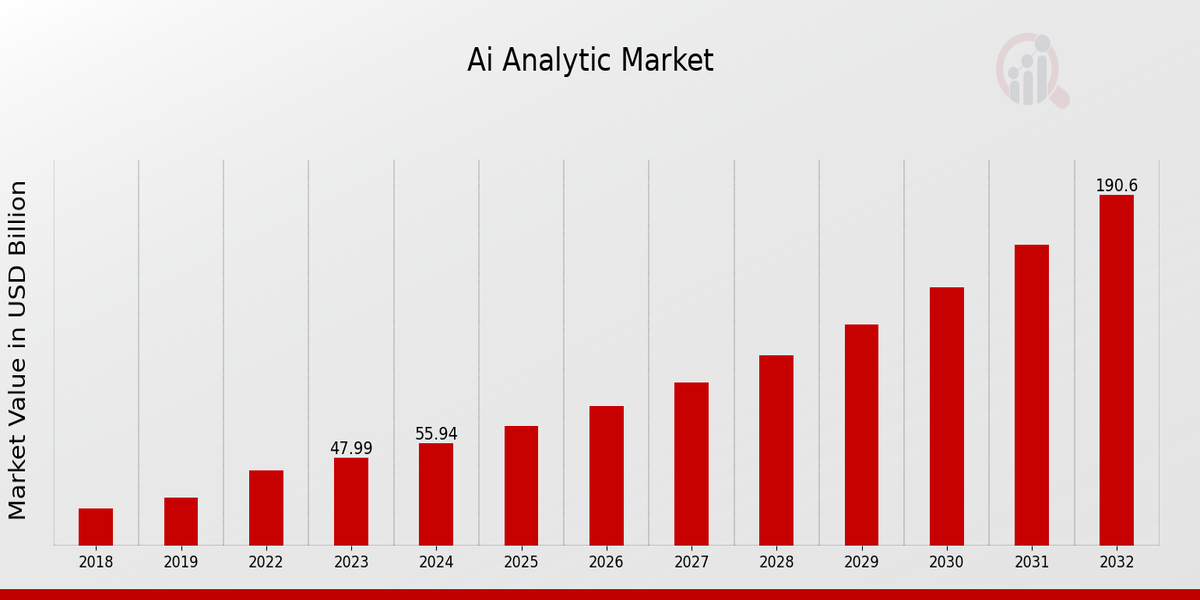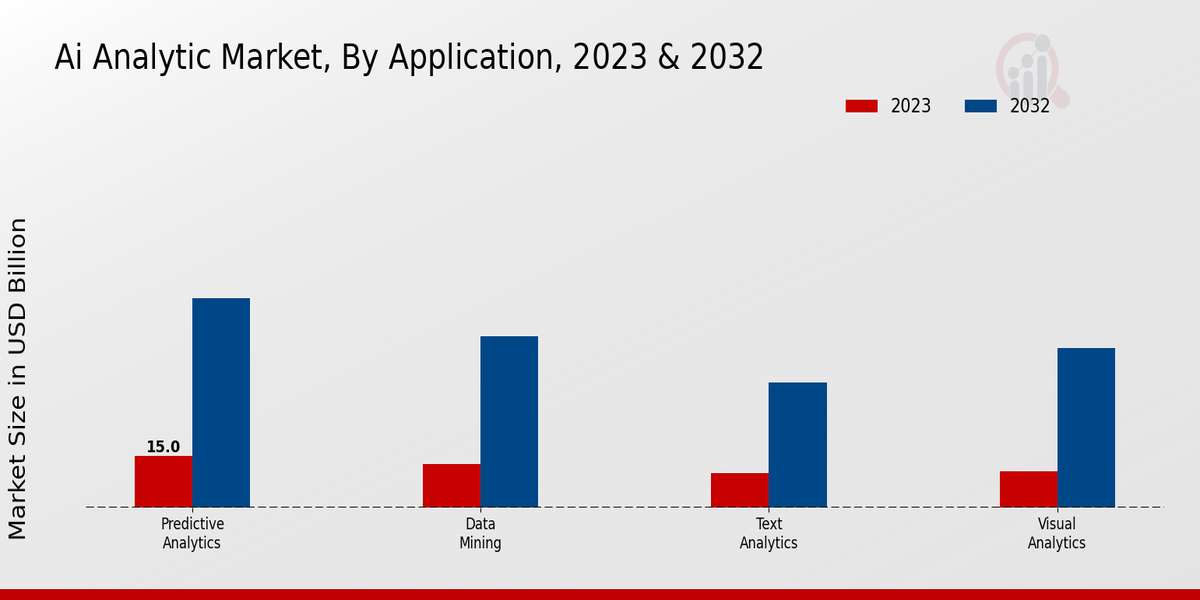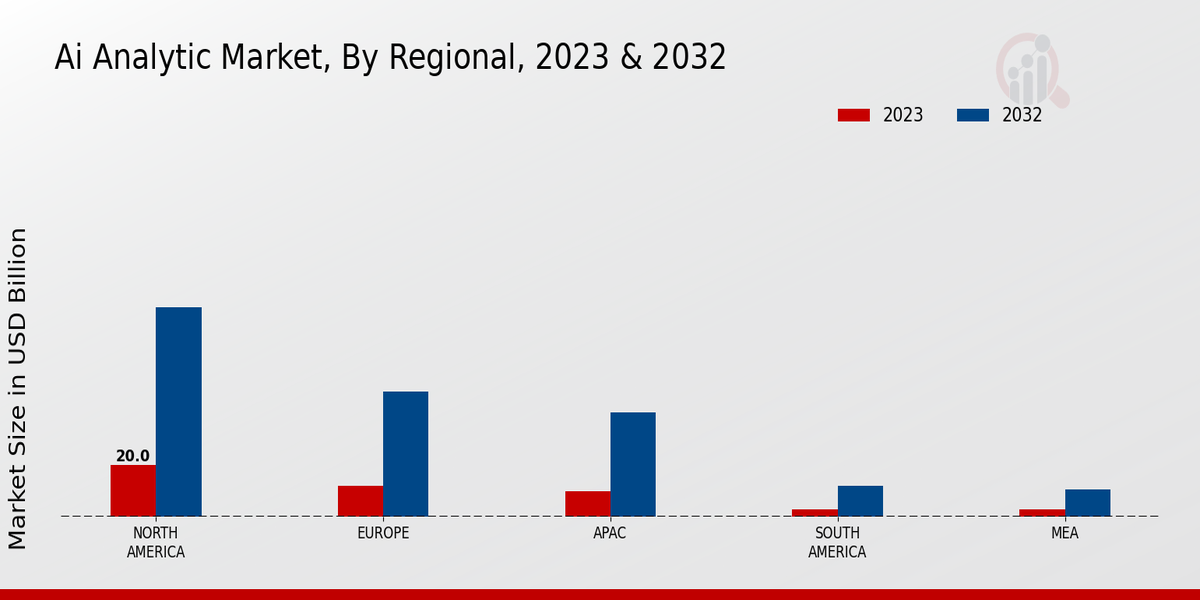AI Analytic Market Overview
As per MRFR analysis, the AI Analytic Market Size was estimated at 41.17 (USD Billion) in 2022. The AI Analytic Market Industry is expected to grow from 47.99(USD Billion) in 2023 to 190.61 (USD Billion) by 2032. The AI Analytic Market CAGR (growth rate) is expected to be around 16.56% during the forecast period (2024 - 2032).
Key AI Analytic Market Trends Highlighted
The AI Analytic Market is experiencing significant growth, driven by the increasing adoption of data-driven decision-making across various industries. Businesses recognize the value of leveraging artificial intelligence to gain deeper insights from their data, which helps in enhancing operational efficiency and improving customer experiences. The shift towards automation and the need for real-time analytics further fuel this demand. Additionally, the rise of big data, coupled with advancements in machine learning and deep learning technologies, presents a compelling case for organizations looking to stay competitive in the evolving market landscape.
There are numerous opportunities within the AI Analytic Market that organizations can explore. As businesses transition to cloud-based solutions, they can take advantage of scalable AI analytics tools that provide flexibility and cost-effectiveness. Companies that specialize in developing specialized AI applications tailored for specific sectors will find growing demand as industries increasingly seek customized solutions. Furthermore, integrating AI analytics with existing enterprise resource planning (ERP) systems can enhance data processing capabilities, enabling businesses to make better-informed decisions. The potential for partnerships and collaborations within the tech ecosystem also represents a significant opportunity for growth and innovation.
Recent times have seen a surge in trends influencing the AI Analytic Market. Transparency and ethical considerations around AI have gained importance, with companies focusing on explainability and bias mitigation in AI algorithms. There’s also an increasing emphasis on the development of user-friendly interfaces that allow non-technical users to access analytical tools easily. The integration of AI with edge computing is emerging as a key trend, allowing data analytics to occur closer to where data is generated, thus improving responsiveness and efficiency. As these trends continue to evolve, they will shape the future landscape of the AI Analytic Market, making it more dynamic and accessible to a broader range of users and industries.

Source: Primary Research, Secondary Research, MRFR Database and Analyst Review
AI Analytic Market Drivers
Increasing Demand for Data-Driven Decision Making
The need for data-driven decision making is a significant driver for the AI Analytic Market Industry. Organizations across various sectors are increasingly recognizing the importance of leveraging data to gain actionable insights that can enhance their operational efficiency and competitiveness. With the exponential growth of data generated from multiple sources, including social media, IoT devices, and traditional transactional systems, businesses find themselves inundated with information that can be overwhelming without proper analysis.
AI analytics provides advanced tools and technologies to process large volumes of data quickly and accurately, facilitating deeper insights and aiding in better strategic planning. Additionally, the capability of AI to uncover trends and patterns that may not be immediately visible to human analysts empowers organizations to make more informed choices regarding marketing strategies, product development, and customer engagement. This paradigm shift towards data-centric operational strategies is accelerating the adoption of AI analytics solutions, establishing it as a cornerstone for achieving business intelligence and sustaining market growth.
As this trend persists, the AI Analytic Market is projected to experience substantial growth, driven by an ever-increasing commitment to harnessing the power of data. Furthermore, the convergence of AI with other technologies, such as cloud computing and big data, is making it easier for businesses to implement these analytics solutions. The scalability and flexibility offered by these technologies ensure that organizations, regardless of their size, can benefit from AI analytics, thus expanding the market's potential. Consequently, as more enterprises seek to transform their data into valuable business assets, the demand for AI analytic tools is expected to rise, marking a promising future for the AI Analytic Market Industry.
Rapid Technological Advancements
The AI Analytic Market Industry is significantly propelled by rapid technological advancements in AI and machine learning. As new algorithms and tools are developed, organizations can leverage these innovations to enhance their data analytical capabilities. These advancements facilitate the creation of more sophisticated models that can analyze and interpret complex datasets, making it easier for businesses to extract valuable insights. This continual evolution ensures that solutions remain relevant, effective, and capable of meeting the changing demands of the market, ultimately driving growth in the sector.
Growing Investment in AI Research and Development
Investment in AI research and development is steadily increasing, which acts as a strong driver for the AI Analytic Market Industry. Governments, private companies, and venture capitalists are recognizing the transformative potential of AI technologies and are channeling significant resources into R&D efforts. This increased funding not only fosters innovation and product development but also improves the quality of AI analytic tools available in the market. As competition intensifies, companies strive to differentiate themselves by offering cutting-edge solutions, thereby catering to the rising demand for advanced analytics capabilities.
AI Analytic Market Segment Insights
AI Analytic Market Application Insights
The Application segment of the AI Analytic Market represents a substantial portion of the overall market, which was valued at 47.99 USD Billion in 2023 and is expected to experience significant growth, reaching 190.61 USD Billion by 2032. This segment encompasses several critical areas, including Predictive Analytics, Data Mining, Text Analytics, and Visual Analytics, each contributing uniquely to the evolution of market dynamics. Among these, Predictive Analytics stands out with a valuation of 15.0 USD Billion in 2023, projected to grow to 60.0 USD Billion by 2032, making it a significant driver of market growth.
This prominence is attributable to businesses increasingly helping anticipate future trends and making data-driven decisions. Data Mining follows closely, holding a market value of 12.5 USD Billion in 2023 and expected to expand to 49.0 USD Billion by 2032, affirming its relevance in extracting valuable insights from extensive datasets. Text Analytics also plays a vital role, valued at 10.0 USD Billion in 2023 and anticipated to grow to 36.0 USD Billion by 2032. This segment is pivotal as it aids organizations in understanding customer sentiment, thereby enhancing customer engagement.
Visual Analytics, which facilitates the presentation of complex data in an understandable format, is valued at 10.49 USD Billion in 2023, with an expected growth to 45.61 USD Billion by 2032. This capability ensures that insights are easily digestible for stakeholders across various levels. The market growth within this Application segment is enhanced by technological advancements, an increasing emphasis on data-driven strategies, and the growing demand for real-time analytics. However, challenges such as data privacy concerns and the need for skilled professionals in AI remain.
Overall, the insights gained from this segment reveal its criticality in forming strategies that drive competitive advantage in an increasingly data-centric world. The segmentation of the AI Analytic Market enables stakeholders to harness specific areas effectively, tailoring solutions to meet evolving market needs.

Source: Primary Research, Secondary Research, MRFR Database and Analyst Review
AI Analytic Market End-Use Industry Insights
The AI Analytic Market is experiencing significant growth driven by various end use industries, with a market value of approximately 47.99 USD Billion in 2023, projected to soar as new technologies are adopted. Within the healthcare sector, AI analytics is enhancing diagnostic accuracy and treatment personalization, while the retail industry leverages data analytics for consumer behavior insights and inventory management. Financial services utilize AI to streamline operations and risk management, significantly improving efficiency. Manufacturing is also seeing an uptick as AI fosters predictive maintenance and process automation.
The major demand from these industries showcases the impactful role they play in shaping AI Analytic Market revenue, guiding robust market growth. Additionally, these sectors are adapting to rapid digital transformation, presenting both lucrative opportunities and challenges in implementing AI solutions effectively. With the increasing importance of data-driven decision-making, the AI Analytic Market segmentation is evolving, reflecting the unique needs and advancements within each industry.
AI Analytic Market Deployment Type Insights
The AI Analytic Market revenue reflects a significant shift toward various deployment types, particularly driven by technological advancements and the growing need for efficient data analysis. In 2023, the market is valued at 47.99 billion USD and is poised for substantial growth over the coming years. The Deployment Type segmentation showcases distinct preferences among enterprises, highlighting the increasing adoption of Cloud-Based solutions, which provide scalability and cost-effectiveness. On-premise systems also maintain relevance, favored by organizations prioritizing data security and control.
Furthermore, Hybrid deployment methods are gaining traction, as they offer flexibility and allow companies to leverage both on-premise and cloud resources effectively. These trends indicate a dynamic landscape within the AI Analytic Market industry, with businesses operating in diverse environments to address unique operational needs. The market's continuous evolution is fueled by the pursuit of enhanced analytics capabilities, but challenges such as integration complexities and maintenance costs remain prevalent. Nevertheless, opportunities for growth in this sector are abundant, presenting a promising path for companies seeking to optimize their AI analytic strategies within these deployment frameworks. AI Analytic Market statistics reflect a robust trajectory toward 190.61 billion USD by 2032, underscoring the critical role of deployment strategy in overall market growth.
AI Analytic Market Analytics Type Insights
The AI Analytic Market, valued at 47.99 USD Billion in 2023, showcases significant demand across various Analytics Types, which include Descriptive Analytics, Diagnostic Analytics, Prescriptive Analytics, and Predictive Analytics. This market is marked by robust growth driven by advancements in machine learning and data-driven decision-making practices. Each type serves crucial roles; for instance, Descriptive Analytics helps in understanding historical data trends, while Diagnostic Analytics delves deeper to explain why certain outcomes occurred.
Predictive Analytics is gaining momentum due to its capability to forecast future events using existing data, making it valuable for businesses looking to minimize risks and maximize opportunities. Similarly, Prescriptive Analytics offers actionable recommendations based on data analysis, assisting organizations in optimizing their operational strategies. The diverse applications and urgency for data-driven insights across industries underline the increasing significance of these analytics types within the overall AI Analytic Market segmentation. With projected market growth, the integration of these capabilities is expected to further enhance the interpretation of AI Analytic Market data, addressing emerging challenges and unlocking new opportunities.
AI Analytic Market Regional Insights
The AI Analytic Market is projected to showcase significant regional variations, with North America holding a majority share valued at 20.0 USD Billion in 2023 and expected to escalate to 80.0 USD Billion in 2032, highlighting its dominance driven by advanced technological adoption and a robust infrastructure. Europe follows with a valuation of 12.0 USD Billion in 2023 and is anticipated to reach 48.0 USD Billion by 2032, reflecting a growing emphasis on AI implementation across sectors like finance and healthcare. The APAC region also demonstrates substantial growth potential, starting with 10.0 USD Billion in 2023 and projected to climb to 40.0 USD Billion by 2032, benefitting from rapid industrialization and increasing investments in data analytics.
In contrast, South America and the MEA regions are smaller contributors, with values of 3.0 USD Billion and 2.99 USD Billion in 2023, respectively, forecasted to increase to 12.0 USD Billion and 10.61 USD Billion by 2032. While South America is gaining momentum due to emerging startups, the MEA region is projected to grow through strategic collaborations in technology. Overall, the AI Analytic Market revenue growth across these regions presents diverse opportunities driven by distinct local demands and challenges.

Source: Primary Research, Secondary Research, MRFR Database and Analyst Review
AI Analytic Market Key Players and Competitive Insights
The AI Analytic Market has experienced significant growth as businesses across various sectors increasingly adopt AI-driven solutions to enhance their data analysis capabilities. This surge in demand for AI analytics is due in part to the growing need for businesses to make data-driven decisions that can improve operational efficiency and drive revenue. Competitive insights within this market indicate a landscape filled with innovation as companies strive to offer diverse and advanced AI analytic tools. These tools range from machine learning models to predictive analytics, each designed to empower organizations to harness their data in smarter ways. As more players enter this dynamic market, understanding the competitive positioning of key companies becomes essential for stakeholders aiming to capitalize on current and emerging opportunities.
DataRobot has established itself as a prominent player in the AI Analytic Market, recognized for its automated machine learning platform that caters to a wide range of industries seeking to leverage AI for better decision-making. The company's strengths lie in its ability to promote rapid deployment and user-friendly interfaces, enabling organizations to quickly interpret complex data without requiring extensive statistical or programming knowledge. DataRobot's commitment to enhancing the accessibility of AI tools allows clients to implement predictive insights efficiently, fostering a culture of data-driven decision-making. By consistently refining its offerings and expanding its functionalities, DataRobot reinforces its market presence and competitive edge, appealing to businesses that prioritize speed and ease of use in their analytics processes.
Oracle also holds a significant position in the AI Analytic Market, driven by its comprehensive cloud-based solutions that integrate AI and machine learning into various business applications. Oracle's strengths include its extensive industry knowledge and robust infrastructure, which enable organizations to perform advanced analytics on large volumes of data in real-time. The company's emphasis on secure data management and compliance resonates with enterprises looking to enhance their data governance structures while harnessing AI for strategic insights. Furthermore, Oracle's ongoing investment in developing new AI capabilities, such as intelligent automation and enhanced data visualization, reinforces its ability to meet the evolving demands of the market. With a strong global footprint and a diverse suite of AI analytic tools, Oracle continues to attract a broad spectrum of clients seeking innovative solutions to complex business challenges.
Key Companies in the AI Analytic Market Include
- DataRobot
- Oracle
- SAS Institute
- Alteryx
- MicroStrategy
- SAP
- Honeywell
- Microsoft
- Amazon
- Tibco Software
- Qlik
- IBM
- Salesforce
- Palantir Technologies
- Google
AI Analytic Market Industry Developments
The AI Analytic Market has seen significant developments recently, with companies like DataRobot, Oracle, and SAS Institute expanding their AI capabilities and product offerings to stay competitive. These firms are increasingly leveraging machine learning and advanced analytics to provide enhanced insights for business decision-making. In the realm of mergers and acquisitions, notable activity includes Oracle's acquisition of Cerner, enhancing its healthcare analytics portfolio, while SAP has been focusing on strategic partnerships to scale its AI applications. Companies like Amazon and Microsoft continue to invest heavily in AI technologies, looking to augment their cloud services with analytics tools that serve diverse industries. Growth in the market valuation of leading firms is notable as Microsoft and Google push towards integrating AI more deeply into their existing platforms, thereby influencing market dynamics. The AI Analytic Market is expected to grow exponentially, driven by the increasing demand for data-driven decision-making across sectors such as finance, healthcare, and manufacturing, highlighting the critical role of AI-driven analytics in shaping future business landscapes.
AI Analytic Market Segmentation Insights
-
AI Analytic Market Application Outlook
- Predictive Analytics
- Data Mining
- Text Analytics
- Visual Analytics
-
AI Analytic Market End Use Industry Outlook
- Healthcare
- Retail
- Financial Services
- Manufacturing
-
AI Analytic Market Deployment Type Outlook
- On-Premise
- Cloud-Based
- Hybrid
-
AI Analytic Market Analytics Type Outlook
- Descriptive Analytics
- Diagnostic Analytics
- Prescriptive Analytics
- Predictive Analytics
-
AI Analytic Market Regional Outlook
- North America
- Europe
- South America
- Asia Pacific
- Middle East and Africa
AI Analytic Market Report Scope
|
Report Attribute/Metric
|
Details
|
|
Market Size 2022
|
41.17(USD Billion)
|
|
Market Size 2023
|
47.99(USD Billion)
|
|
Market Size 2032
|
190.61(USD Billion)
|
|
Compound Annual Growth Rate (CAGR)
|
16.56% (2024 - 2032)
|
|
Report Coverage
|
Revenue Forecast, Competitive Landscape, Growth Factors, and Trends
|
|
Base Year
|
2023
|
|
Market Forecast Period
|
2024 - 2032
|
|
Historical Data
|
2019 - 2023
|
|
Market Forecast Units
|
USD Billion
|
|
Key Companies Profiled
|
DataRobot, Oracle, SAS Institute, Alteryx, MicroStrategy, SAP, Honeywell, Microsoft, Amazon, Tibco Software, Qlik, IBM, Salesforce, Palantir Technologies, Google
|
|
Segments Covered
|
Application, End Use Industry, Deployment Type, Analytics Type, Regional
|
|
Key Market Opportunities
|
Advanced predictive analytics applications, Integration with IoT devices, Industry-specific AI solutions, Enhanced data security features, Real-time analytics in decision-making
|
|
Key Market Dynamics
|
Rapid technological advancement, Increasing data volume, Growing demand for automation, Rising investment in AI, Enhanced decision-making capabilities
|
|
Countries Covered
|
North America, Europe, APAC, South America, MEA
|
Frequently Asked Questions (FAQ) :
The AI Analytic Market is expected to be valued at 190.61 USD Billion by 2032.
The expected CAGR for the AI Analytic Market from 2024 to 2032 is 16.56%.
North America holds the largest market share, valued at 80.0 USD Billion by 2032.
The market value of Predictive Analytics is expected to reach 60.0 USD Billion in 2032.
Key players include DataRobot, Oracle, SAS Institute, and Microsoft, among others.
The projected market value of Data Mining is expected to be 49.0 USD Billion by 2032.
The AI Analytic Market in Europe is expected to be valued at 48.0 USD Billion by 2032.
The market value of Text Analytics is projected to be 36.0 USD Billion by 2032.
The expected market size for Visual Analytics is anticipated to be 45.61 USD Billion by 2032.
The Asia-Pacific region's market for AI Analytics is expected to be valued at 40.0 USD Billion by 2032.





























